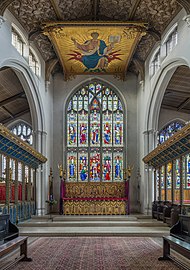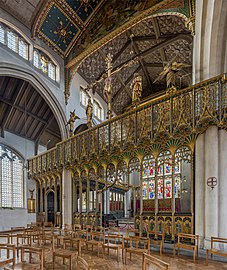St Cyprian's, Clarence Gate
This article needs additional citations for verification. (September 2009) |
| St. Cyprian's, Clarence Gate | |
|---|---|
 The exterior of St Cyprian's church | |
| 51°31′28″N 0°09′36″W / 51.5244°N 0.1599°W | |
| OS grid reference | TQ2782 |
| Location | Glentworth Street, Regent's Park, London NW1 6AX |
| Country | United Kingdom |
| Denomination | Church of England |
| Churchmanship | Anglo-Catholic |
| Website | stcyprians |
| Architecture | |
| Heritage designation | Grade II* listed |
| Architect(s) | Ninian Comper |
| Style | Gothic Revival |
| Years built | 1903 |
| Administration | |
| Diocese | Diocese of London |
| Archdeaconry | Charing Cross |
| Deanery | Westminster Marylebone |
| Parish | St. Cyprian, Marylebone |
St Cyprian's Church is a Parish Church of the Church of England in the Marylebone district of London, UK, founded in 1866 by Father Charles Gutch. It is dedicated to Saint Cyprian, a third-century martyr and Bishop of Carthage and is located by the south-western corner of Regent's Park, next to Clarence Gate Gardens just off Baker Street.
History
Father Charles Gutch, who was previously curate at St Matthias', Stoke Newington, St Paul's, Knightsbridge, and All Saints, Margaret Street, was anxious to acquire a church of his own in London, so that he could manage it in his own style. He proposed to build a mission church in a poor and neglected northeastern corner of Marylebone, which would require a portion of the parishes of St Marylebone and St Paul, Rossmore Road to be handed over. However, neither the Rector of St Marlebone nor the Vicar of St Paul's approved of the churchmanship of Father Gutch. Further, he proposed to dedicate the mission to St Cyprian of Carthage, explaining:[1]
"I was especially struck by his tender loving care for his people, the considerateness with which he treated them, explaining to them why he did this or that, leading them on, not driving them. And I said, 'If only I can copy him, and in my poor way do as he did, I too may be able to keep my little flock in the right path, the road which leads to God and Heaven'."
This caused further difficulties, and only a few weeks before the mission was due to be opened, the Bishop of London protested, claiming that the dedication would be against his and his predecessor's rules, and suggested that the district be named after one of the Apostles instead. Farther Gurch pointed out that a number of other churches in the Diocese had recently been dedicated to other saints, and the dedication to St Cyprian was allowed to remain. It celebrated its first Eucharist on 29 March 1866.[1]
Over the next thirty years, St Cyprian Mission Church flourished, but the church building could only hold one hundred and eighty and became overcrowded. Lord Portman, however, refused to make available a site which would allow the building of a larger church, as he too did not like Gutch's churchmanship. Charles Gutch died in 1896 with his vision of a larger permanent church unrealised. The Bishop of London, Mandell Creighton, appointed Reverend George Forbes of St Paul's Church in Truro, Cornwall, as his successor. Forbes immediately stressed that a new permanent church was urgently required, and in 1901, Lord Portman agreed to sell a site for £1000, well below market value, provided that it could be demonstrated that sufficient funds were available to build the church and be ready for consecration by 1 June 1904. It was completed with almost a year to spare, and was dedicated to the glory of God and the memory of Charles Gutch by the new Bishop of London, Arthur Winnington-Ingram. At this time, the church interior was little more than four walls and pillars, although the altars were furnished. The completion of the interior decoration was to be left for succeeding generations.[1]
Architecture
The church was designed by Ninian Comper in a Gothic Revival style and built in 1903. It was built in red brick with stone dressings. The building has a nave, aisles and clerestory, but no tower, and features Perpendicular window tracery and stained glass by Comper. St Cyprian's was designed to reflect Comper's emphasis on the Eucharist and the influence on him of the Oxford Movement, and he said his church was to resemble "a lantern, and the altar is the flame within it".[2]
The interior, also in the Perpendicular style, features a white and gold colour scheme with ornate furnishings, including a finely carved and painted rood screen and a gilded classical font cover. The timber hammerbeam roof features tie beam trusses with panelled tracery spandrels. Comper's stated aim was "to fulfil the ideal of the English Parish Church ... in the last manner of English Architecture".[3]
The building is regarded as one of London's most beautiful churches. Ian Nairn described the church as "a sunburst of white and gold and all-embracing love… the moment you go in through the door you know that everything is absolutely right".[4]
- The interior
-
The sanctuary
-
The nave
-
The ceiling
-
The rood screen
Notes and references
- ^ a b c "St Cyprian's Church History". St Cyprian's Church. Retrieved 5 February 2015.
- ^ Brooks, Edited by Chris; Saint, Andrew (1995). The Victorian church : Architecture and society. Manchester: Manchester University Press. ISBN 978-0-7190-4020-7.
{{cite book}}:|first=has generic name (help) - ^ Historic England. "Church of St Cyprian, Clarence Gate (1237476)". National Heritage List for England. Retrieved 2 March 2012.
- ^ "Why Ian Nairn, outspoken critic of postwar modernism, is as relevant as ever". The Grauniad. Retrieved 29 December 2013.
External links
- http://www.stcyprians.org.uk/ – official website
- Church of England church buildings in the City of Westminster
- Music venues in London
- Churches completed in 1903
- 20th-century Church of England church buildings
- Gothic Revival church buildings in London
- Gothic Revival architecture in London
- Anglo-Catholic church buildings in the City of Westminster
- Grade II* listed churches in the City of Westminster





